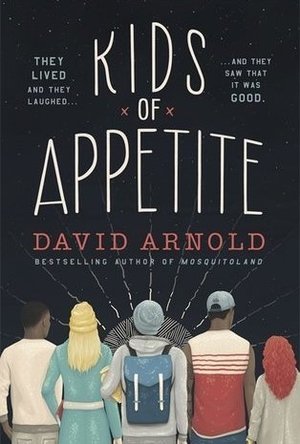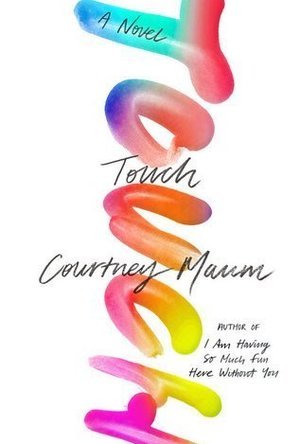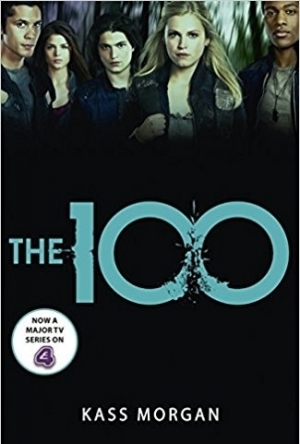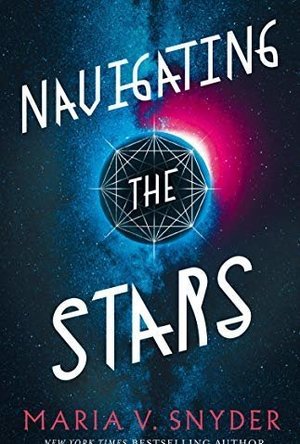
Navigating the Stars (Sentinels of the Galaxy Book 1)
Book
“The answer is no, Lyra,” my mother utters her favorite—I swear—phrase. No means I have...
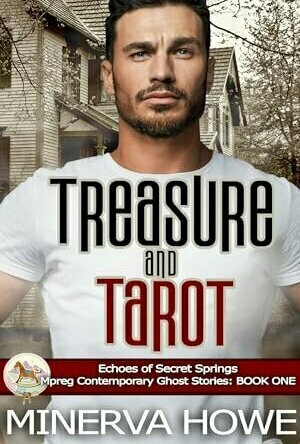
Treasure and Tarot (Echoes of Secret Springs #1)
Book
It's been five years since Colton Maxwell left Sebastian behind to go on a quick adventure. He was a...
MM Romance Mpreg Supernatural
Hazel (1853 KP) rated Kids of Appetite in Books
Dec 14, 2018
They lived and they laughed and they saw that it was good.</i>
<i>Mosquitoland </i>was the best book I read last year (2015) and I was excited to discover what David Arnold would write next. I approached<i> Kids of Appetite</i> with mild trepidation; what if it did not live up to my expectations? Need not have worried – it was brilliant. Dubbed a “tragicomedy” <i>Kids of Appetite</i> is a combination of realistic, heartbreaking experiences with intellectual humour.
The book opens mid interview at a local police station where two teenagers, Vic and Mad, are being questioned about a murder their friend has supposedly committed. From there, the story backtracks a week and proceeds to bring the reader up to date. It all begins with Vic running away from home, distancing himself from his mother and her new partner. By chance, a coincidence – a bump, Vic would say – he is found by Mad who introduces him to a small group of homeless friends. Vic may not have packed in preparation for life on the streets – or in a greenhouse as it turns out – however he did grab the urn containing his late father’s ashes before racing out of the house. Along with the urn is a letter containing cryptic clues that lead to various locations that Vic’s father wished for his ashes to be scattered. He, along with his new found friends; make it a mission to put his father to rest.
It is not possible to label the general theme of the book. <i>Kids of Appetite</i> is a story full of stories. Each character has their own past, something that led them to the situation they find themselves in now. The group consists of five members – once Vic has been accepted. Baz, at age twenty-seven, is clearly the leader: responsible, caring, and fatherly – until accused of murder. Seven years younger is Zuz, Baz’s mute brother, and finally Coco, an eleven year old with the mouth of a foul old lady. It is Coco, amongst all her swearing and hilarious misuse of words, that coins the name <i>Kids of Appetite, KOA</i> for short, a play on words: they are not solely in want of food, they hunger for life.
Initially it would appear that the main focus will be on Vic: his father’s death, his mother’s new partner, Moebius (facial paralysis) – a syndrome that results in a lot of bullying and discrimination – and, of course, his flight from home. However the remaining members of <i>KOA </i>equally contribute to the overall narrative. Mad, like Vic, knows what it is like to lose a father. Unfortunately she also knows what it is like to lose a mother. Her life since the fateful car crash that left her and orphan has been full of abuse and uncertainty. Baz and Zuz, on the other hand, have escaped a traumatizing childhood in the midst of the Congo Civil War.
Similarly with <i>Mosquitoland</i>, Arnold’s second book is full of intellectual knowledge and humour complete with references to highbrow material. Vic is obsessed with an operatic song and deeply interested in abstract art, particularly Matisse. He pulls the artist’s work apart in search of meaning and relatable truths of life. Like Vic, Mad has a particular song she draws comfort from. The lyrics help her make sense of the world around her, and produce her own manifesto – Madifesto, rather. She is particularly fascinated by S E Hinton’s <i>The Outsiders</i> – a book I have not read, but am obviously going to now. With in-depth theories purloined from her favourite novel, she encourages and advises those around her.
The murder investigation is evidently another key point of the book. I do not want to say too much on the matter as it would not be fair to give the ending away. Be reassured that<i> Kids of Appetite</i> is not a thriller, crime or horror novel; it is the events and dialogue leading up to the conclusion that make up the greatest parts of the story.
It is essentially the characters that make <i>Kids of Appetite</i> such a fantastic work of fiction. Their background stories are all based on real life experiences of many people throughout the world, but it is their opinion of life, their terminology, and their reckless enthusiasm that really impacts the reader. <i>Kids of Appetite</i> is a book to be read over and over again. So many phrases can be lifted and quoted to explain our own lives and feelings. In fact, the entire novel is one big quote to sum up life itself. Although there are so many themes, stories and ideas, there is one clear message. Let go. Let go of the past. Let go of the things that hold you back. For Vic and Mad it is the death of their parents; for Coco it is abandonment; and Baz and Zuz learn to let go of their violent childhood.
David Arnold is an extremely talented author, seamlessly flowing from one notion to another, whilst sweeping the reader into a sea of pure emotion. He may over use the word “ergo” and have an unconventional penchant for ellipses, but that only adds to the uniqueness of the writing. There may be an excessive amount of expletives, however that is overshadowed by the pure genius of the story itself. <i>Kids of Appetite</i> is a book I want to recommend to all. The blurb likens it to authors Rainbow Rowell and Jennifer Niven – I would like to throw John Green into the mix – and should appeal to many Young Adult readers. I could write forever about this book, but I would rather you go and read it yourself. And whilst you read, remember:
<i>They lived and they laughed and they saw that it was good. </i>

Sukhmani Sahib : Paath in Gurmukhi Hindi English Translation and Meaning
Book and Reference
App
Sukhmani Sahib now in Gurmukhi, Hindi, English and also Translation in English. Each line is...
James P. Sumner (65 KP) rated Gemini Man (2019) in Movies
Oct 11, 2019
When he finds out his last job wasn't all it seemed, he starts asking questions, which quickly prompts the agency to try and retire him themselves. We know from the trailers that a younger clone of himself is sent to kill him, and so begins a typical cat-and-mouse gunfight across the globe.
*sigh*
I was really disappointed with this film. It had so much potential - a strong lead with great support from Clive Owen (in fine antagonistic form), Benedict Wong (playing another Wong-esque character) and Mary Elizabeth Winstead (in a commanding, if at times a little bland, outing). But even a good turn from Mr. Smith can't stop it from ultimately becoming a victim of its own ambition.
The plot isn't especially original, but has a nice twist to it that sets it apart. However, it loses itself halfway through, becoming convoluted and indecipherable, seemingly even for the cast. Nothing feels like it has any meaning, and the promising start was soon forgotten in favour of one set piece after another.
And speaking of the set pieces, whilst the action and choreography is really good, the scenes with Will Smith vs. Will Smith (both fighting and talking) are ruined by poor CGI. It's too obviously computer-generated. To me, good CGI looks integrated into the real life scenes, but this stands out like a video game. The action scenes in particular are way too fast and unrealistic. It's like they're trying to recreate the gritty, hard-hitting pace and tone of the Bourne films, but end up with The Matrix being playing on fast forward.
Ang Lee is the kind of director who either wins big (see "Life Of Pi (2012)") or loses big (see "Hulk (2003)"). I don't know where the blame lies here. The script wasn't particularly bad. The direction was... okay. But nothing seemed to gel. It had all the right ingredients and should've been great, yet it fails in every aspect.
This could've been one of the year's best blockbusters... sadly, it's a forgettable tale that Will Smith will likely want wiping from his IMDB profile.
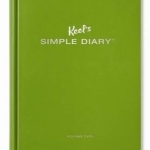
Keel's Simple Diary: v. 2
Book
This title is available in 6 delicious colors. In a world where products are out as soon as they're...
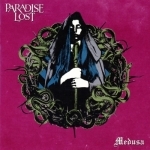
Medusa by Paradise Lost
Album Watch
Most people will know Medusa as the Gorgon from Greek mythology; she is the infamous beast with...
metal
This book immediately got off on the wrong foot with me as the main character ranted against how society has changed--using peanut allergies and the horror of having to avoid her favorite peanut-filled treats on a plane as proof. As someone with a kid with a peanut allergy (who has met these lovely people on planes in real life), I was already turned off by Sloane. <i>It never really got any better. </i>
Sloane is supposedly a trend forecaster. Her entire life she's been able to "see" things and predict where society is going with certain trends. She is credited with foreseeing the famous "swipe" action. The problem Sloane faces now is that she thinks society is going to turn against the technology it has come to hold so dear: something that doesn't sit well with the technology-focused firm, Mammoth, who has hired her. After all, Mammoth uses a driverless car to transport Sloane while she works for them. They want her to present at a convention that aims to showcase technology for the childless set.
On the surface, this doesn't sound so bad. Consider parts of it satire and a critique on our tech-obsessed society, and it has real promise. Unfortunately, for me, <i>the premise fell flat.</i> My favorite character wound up being Anastasia, the driverless car. Sloane's boyfriend, Roman, wears a Zentai suit (imagine a full-length wet-suit that covers his entire body) and preaches an anti-touch, pro-cybersex agenda. He's strange. That whole part of the plot is weird, albeit one that offers the occasional comic moment. Maybe my sense of humor is not finely developed enough?
The book nails a lot of the corporate world (you can certainly picture Dax, the head of Mammoth, and many of his worker bees). Other parts of the plot are harder to swallow. Sloane waffles. Roman irritates. The dialogue is oddly written at times. Large pieces of the plot didn't really seem necessary. Other pieces were interesting, but felt like reading a research paper (and I found myself skimming).
So while there were certainly funny moments (and it picked up a bit as it neared the end), overall I just found myself cringing. I didn't like the plot, I never warmed up to Sloane, and I wanted to hit Roman and Dax. Maybe I missed a higher meaning to this novel, as it seems to be getting a lot of better reviews, so take mine with a grain of salt. For me, I just didn't enjoy reading it, and that's why (and I debated this a while), I'm going with 2.5 stars.
I received a copy of this novel from the publisher and Netgalley (thank you!) in return for an unbiased review. It is available everywhere as of 05/30/2017.
<center><a href="http://justacatandabookatherside.blogspot.com/">Blog</a>; ~ <a href="https://twitter.com/mwcmoto">Twitter</a>; ~ <a href="https://www.facebook.com/justacatandabook/">Facebook</a>; ~ <a href="https://plus.google.com/u/0/+KristyHamiltonbooks">Google+</a></center>;
<i>This eBook was provided by the publisher via NetGalley in exchange for an honest review</i>
The recently televised novel <i>The 100</i> by Kass Morgan is the first in a unique dystopian series set centuries into the future. Cataclysmic nuclear and biological wars rendered Earth uninhabitable forcing humans to create a new life in space on a very large ship. Three hundred years later scientists judge that the harmful radiation that destroyed Earth may have reduced or even completely disappeared meaning that the planet would finally be safe for humans. To test this theory the Colony sends one hundred adolescent lawbreakers with the mission to begin to recolonize Earth.
The novel is told from the point of view of four characters: Clarke, Wells, Bellamy and Glass. The first three are on the drop ship to Earth, however Glass escapes at the very last second and remains behind. Although there may be a hundred people on this mission, none of them have any idea what to expect or how to live on a planet. It does not help matters when the drop ship crash lands leaving them, particularly Clarke, the only one with medical knowledge, with an even more difficult situation than they were anticipating. Meanwhile, back on ship Glass is discovering that human life may be in as much danger there as they would be on Earth.
Each character also has flashbacks to their life on the ship, which gradually reveals the events that led up to them being convicted as criminals and thus sent to their new lives, or even possible deaths. Due to this there was less action set on Earth than there could have been – there was not enough time for a <i>Lord of the Flies</i> situation to arise. However it was fascinating to imagine their reaction to the first time they saw the sun set or felt the rain; being mesmerized by bird song and enjoying their first ever piece of meat.
As with most young adult novels there is the inevitable romance theme consisting of conflicting feelings and love triangles. The overall situation the main characters found themselves in was, in part, due to actions they committed in the name of love. Sometimes this theme could get a little annoying and hinder the dystopian side of the story, however it would not have been able to function without these elements.
Kass Morgan concludes <i>The 100</i> at the peak of the climax leaving us desperately wanting to find out what happens next. This is a highly recommended book for young adult readers with a love for science fiction.
Neon's Nerd Nexus (360 KP) rated Doctor Sleep (2019) in Movies
Nov 3, 2019 (Updated Nov 4, 2019)
Characters are all so likable and we spend a good chunk of time with all (including the menacing and creepily intimidating villains) which I thought was really nice and this helps create great attachment meaning that when a death hits you really feel the impact of the loss adding poweful emotion and a small amount of grievence to each one (and adds to the running theme of all life being important and death being something everyone fears/cant escape). Acting is great especially with the new cast replicating old characters from the shining. Doctor sleep also gets nostalgia right using parts of the shining respectfuly and tastfully rather than just simply replicating them for a cheap cash grab, instead choosing to intrigate them as crucial parts of the plot. All in all this movie unnerved me, engrosed and provoked me making me think more on the subject of death the journey we all take towards and how we should all pay more care and give more thought to the ones we let go.
